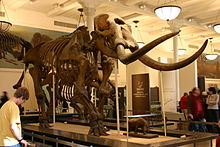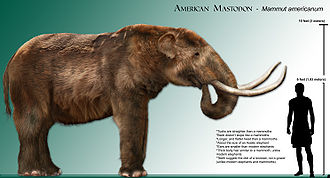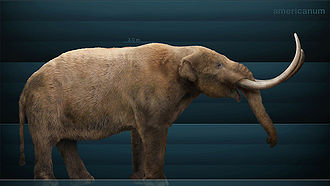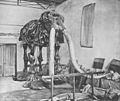- American mastodon
-
American mastodon 
Mammut americanum skeleton at the AMNH Scientific classification 
Kingdom: Animalia Phylum: Chordata Class: Mammalia Order: Proboscidea Family: †Mammutidae Genus: †Mammut Species: †M. americanum Binomial name Mammut americanum
(Kerr, 1792)The American mastodon (Mammut americanum) is an extinct North American proboscidean that lived from about 3.7 million years ago until about 10,000 BC. It was the last surviving member of the mastodon family. Fossil finds range from present-day Alaska and New England in the north, to Florida, southern California, and as far south as Honduras[1] and El Salvador. Its main habitat was cold spruce woodlands, and it is believed to have browsed in herds.[2]
Contents
Description
General
The American mastodon resembled a woolly mammoth (Mammuthus primigenius) in appearance, with a thick coat of shaggy hair.[3] A few skeletons have been found with the fur still attached; examination of the hair suggests that mastodons lacked the undercoat characteristic of mammoths.[4] It was about 3 metres (9.8 ft) in height at the shoulder, also similar to woolly mammoths.
However, there are number of significant skeletal differences between mastodons and mammoths. Mastodons' teeth differ dramatically from those of members of the elephant family; they had blunt, conical, nipple-like projections on the crowns of their molars,[5] which were more suited to chewing leaves than the high-crowned teeth mammoths used for grazing; the name mastodon (or mastodont) means "nipple teeth" and is also an obsolete name for their genus.[6] Their skulls are larger and flatter than those of mammoths, while their skeleton is stockier and more robust.[4]
Tusks
The tusks of the American mastodon sometimes exceeded five metres in length; they curved upwards, but less dramatically than those of the woolly mammoth.[4] Young males had vestigial lower tusks that were lost in adulthood.[4] However, it has been proven that female mastodons had lower pairs of tusks. The tusks were probably used to break branches and twigs, although some evidence suggests males may have used them in mating challenges; one tusk is often shorter than the other, suggesting that, like humans and modern elephants, mastodons may have had laterality.[4] Examination of fossilized tusks revealed a series of regularly spaced shallow pits on the underside of the tusks. Microscopic examination showed damage to the dentin under the pits. It is theorized that the damage was caused when the males were fighting over mating rights. The curved shape of the tusks would have forced them downward with each blow, causing damage to the newly forming ivory at the base of the tusk. The regularity of the damage in the growth patterns of the tusks indicates that this was an annual occurrence, probably occurring during the spring and early summer.[7]
Distribution
Though their habitat spanned a large territory, American mastodons were most common in the ice age spruce forests of the eastern United States, as well as in warmer lowland environments.[8] Their remains have been found as far as 186 miles (300 km) offshore of the northeastern United States, in areas that were dry land during the low sea level stand of the last ice age.[9] Mastodon fossils have been found on the Olympic Peninsula of Washington, U.S. (Manis Mastodon Site),[10] in Kentucky (particularly noteworthy are early finds in what is now Big Bone Lick State Park); the floodplain of the East Branch of the DuPage River, near Glen Ellyn, Illinois;[11] the Kimmswick Bone Bed in Missouri; in Stewiacke, Nova Scotia, Canada; at a number of sites in New York State;[12] in Richland County, Wisconsin (Boaz mastodon); La Grange, Texas; Southern Louisiana; north of Fort Wayne, Indiana; Savannah, Georgia; and Johnstown, Ohio,[13] U.S.
Extinction
M. americanum is generally reported as having disappeared from North America about 10,000 years ago,[14] as part of a mass extinction of the Pleistocene megafauna. However more recent radiocarbon dates have been found, such as 5200 BC in Seneca, Michigan,[15] 5140 BC in Utah,[16] 4150 BC in Washtenaw, Michigan,[17] 4080 BC in Lapeer, Michigan.[18]
Recent studies indicate that tuberculosis was common in late Pleistocene American mastodons, and it has been suggested that this could have contributed to their extinction 10,000 years ago.[19] However, it is not considered plausible that the disease could have caused the extinction on its own.[19]
Another factor contributing to their eventual extinction in America during the late Pleistocene may have been the presence of Paleo-Indians, who entered the American continent and expanded to relatively large numbers 13,000 years ago.[20] Their hunting caused a gradual attrition of the mastodon and mammoth populations, significant enough that over time the mastodons may have been hunted to extinction.[21][22] Analysis of tusks of mastodons from the American Great Lakes region over a span of several thousand years prior to their extinction in the area shows a trend of declining age at maturation; this is contrary to what one would expect if they were experiencing stresses from an unfavorable environment, but is consistent with a reduction in intraspecific competition that would result from a population being reduced by human hunting.[22]
In September 2007, Mark Holley, an underwater archaeologist with the Grand Traverse Bay Underwater Preserve Council who teaches at Northwestern Michigan College in Traverse City, Michigan, said that they might have discovered a boulder (3.5 to 4 feet (1.2 m) high x 5 feet (1.5 m) long) with a prehistoric carving in the Grand Traverse Bay of Lake Michigan. The granite rock has markings that resemble a mastodon with a spear in its side. Confirmation that the markings are an ancient petroglyph will require more evidence.[23]
Taxonomy
M. americanum is a species of the extinct family Mammutidae, related to the proboscidean family Elephantidae (mammoths and elephants). The common name "Mastodon" derives from a genus named to describe various extinct members of proboscideans, Mastodon (Cuvier) is not currently used. The assignment of the taxon to Mammut, a name that preceded Cuvier's description, met with resistance and authors sometimes applied "Mastodon americanus" as an informal name. Common names for the species have sometimes been "ludicrous and misleading ... The Great American Incognitum. The Leviathan Missourium, The Carnivorous Elephant, Ohio Incognitum, Elephas americanus, a Behemoth, The Pseudelephant, Le Grande Mastodonte, Mastodon giganteus and many others".[24]
In other media
The American mastodon is a playable fighter in the video game Fossil Fighters, and an animal in Zoo Tycoon 2: Extinct Animals. The band Mastodon take their name from the animal.
Gallery
-
Mastodon mother and child in the George C. Page Museum at the La Brea Tar Pits, Los Angeles
See also
References
- ^ Polaco, O. J.; Arroyo-Cabrales, J.; Corona-M., E.; López-Oliva, J. G. (2001). "The American Mastodon Mammut americanum in Mexico". In Cavarretta, G.; Gioia, P.; Mussi, M. et al.. The World of Elephants – Proceedings of the 1st International Congress, Rome October 16–20 2001. Rome: Consiglio Nazionale delle Ricerche. pp. 237–242. ISBN 88-8080-025-6. http://www.sovraintendenzaroma.it/content/download/4787/62368/.../237_242.pdf. Retrieved 2008-07-25.
- ^ Palmer, D., ed (1999). The Marshall Illustrated Encyclopedia of Dinosaurs and Prehistoric Animals. London: Marshall Editions. p. 243. ISBN 1-84028-152-9.
- ^ Palmer, D., ed (1999). The Marshall Illustrated Encyclopedia of Dinosaurs and Prehistoric Animals. London: Marshall Editions. pp. 124. ISBN 1-84028-152-9.
- ^ a b c d e Kurtén and Anderson, p. 345
- ^ Mastodons
- ^ Agusti, Jordi and Mauricio Anton (2002). Mammoths, Sabretooths, and Hominids. New York: Columbia University Press. pp. 106. ISBN 0-231-11640-3.
- ^ Fisher, D. (Oct. 18–21, 2006). "Tusk cementum defects record musth battles in American mastodons". Sixty-Sixth Annual Meeting of the Society of Vertebrate Paleontology.
- ^ Kurtén, Björn and Elaine Anderson. Pleistocene Mammals of North America. New York: Columbia University Press, 1980, p. 344.
- ^ Kurtén and Anderson, p. 344.
- ^ Kirk, Ruth and Richard D. Daugherty. Archaeology in Washington. Seattle: University of Washington Press, 2007.
- ^ http://www.wheaton.edu/Perry/start/start.html
- ^ Allmon, Warren D. and Peter L. Nester, editors. Mastodon Paleobiology, Taphonomy, and Paleoenvironment in the Late Pleistocene of New York State: Studies on the Hyde Park, Chemung, and North Java Sites. Ithaca, N.Y.: Paleontological Research Institution, 2008.
- ^ http://www.villageofjohnstown.org/history.html
- ^ "Greek mastodon find 'spectacular'". BBC News. 24 July 2007. http://news.bbc.co.uk/2/hi/europe/6913366.stm. Retrieved 2007-07-24.
- ^ Richard E. Morlan, Bruggeman Mastodon, Canadian Archaeological Radiocarbon Database, www.canadianarchaeology.ca/localc14/c14search.htm, (Hull Quebec: Canadian Museum of Civilization), retrieved online October 2008.
- ^ Wade E. Miller, "Mammut Americanum: Utah's First Record of the American Mastodon", Journal of Paleontology, Volume 61, Number 1, (The Paleontological Society, 1987), 168–183.
- ^ Margaret Ann Skeels, "The Mastodons and Mammoths of Michigan", Michigan Academician, Volume XXXIV, Number 3, (Ann Arbor: Michigan Academy of Science, 2002), 254.
- ^ H. R. Crane and James B. Griffin, Russell Farm, "University of Michigan Radiocarbon Dates IV", Radiocarbon, Volume 1, Number 1, (New Haven: Yale, 1959), 178.
- ^ a b Mastodons Driven to Extinction by Tuberculosis, Fossils Suggest
- ^ Beck, Roger B.; Linda Black, Larry S. Krieger, Phillip C. Naylor, Dahia Ibo Shabaka, (1999). World History: Patterns of Interaction. Evanston, IL: McDougal Littell. ISBN 0-395-87274-X.
- ^ Ward, Peter (1997). The Call of Distant Mammoths. Springer. pp. 241. ISBN 978-0387985725. http://books.google.com/?id=E-JRXiFbcwkC&printsec=frontcover.
- ^ a b Fisher, Daniel C. (2009). "Paleobiology and Extinction of Proboscideans in the Great Lakes Region of North America". In Haynes, Gary. American Megafaunal Extinctions at the End of the Pleistocene. Springer. pp. 55–75. doi:10.1007/978-1-4020-8793-6_4. ISBN 978-1-4020-8792-9. http://www.springerlink.com/content/m39544m241500322/fulltext.pdf.
- ^ Flesher, John (2007-09-04). "Possible mastodon carving found on rock". Associated Press. Archived from the original on 2007-09-04. http://web.archive.org/web/20070904232125/http://news.yahoo.com/s/ap/20070904/ap_on_sc/mastodon_carving. Retrieved 2007-09-05.
- ^ Naming the American Mastodon (reprint). New Jersey State Museum 1960
External links
- The Rochester Museum of Science - Expedition Earth Glaciers & Giants
- Illinois State Museum - Mastodon
- Calvin College Mastodon Page
- American Museum of Natural History - Warren Mastodon
- BBC Science and Nature:Animals - American mastodon Mammut americanum
- Paleontological Research Institute - The Mastodon Project
- Missouri State Parks and Histroric Sites - Mastodon State Historic Site
- Saint Louis Front Page - Mastodon State Historic Site
- The Florida Museum of Natural History Virtual Exhibit - The Aucilla River Prehistory Project:When The First Floridians Met The Last Mastodons
- Western Center for Archaeology & Paleontology, home of the largest mastodon ever found in the Western United States
Categories:- Mastodons
- Pleistocene mammals
- Pleistocene extinctions
- Prehistoric mammals of North America
- Extinct animals of the United States
- Fossil taxa described in 1792
-
Wikimedia Foundation. 2010.




